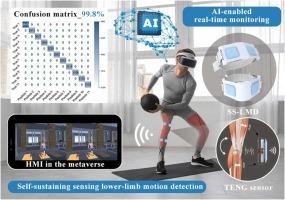一种支持人工智能的自维持感知下肢运动检测系统,用于虚拟世界中的人机交互
IF 17.1
1区 材料科学
Q1 CHEMISTRY, PHYSICAL
引用次数: 0
摘要
鉴于虚拟世界技术的加速发展和对复杂人机交互(HMI)的需求日益增长,对准确可靠的运动检测系统的需求变得更加关键,特别是在医疗保健和康复领域。传统的运动检测系统经常面临诸如便携性有限、依赖外部电源以及在复杂环境下精度不足等挑战。为了解决这些问题,本文提出了一种基于人工智能的自我维持传感下肢运动检测系统(SS-LMD)的开发,该系统专为HMI设计,例如元宇宙中的康复训练。SS-LMD系统包括可穿戴的基于teng的传感器,用于监测下肢肌肉运动,评估不同的深度学习算法,并选择一种先进的实时数据处理方法,采用双长短期记忆模型(LSTM)。该系统的运动识别准确率达到99.8%,无需外部电源即可运行,增强了便携性和用户便利性。通过可用性测试验证了SS-LMD系统在不同年龄用户的虚拟场景健身康复训练中的实际应用。此外,利用5g、数据库和可视化技术,开发了基于数字孪生的监控平台,实时观察用户状态。SS-LMD在自我维持感知和实时捕获下肢运动信息方面表现出卓越的能力,从而提供准确的运动反馈。这一创新代表了可穿戴技术的重大进步,在虚拟健身、智能医疗和老年人康复等领域的虚拟应用中有着巨大的前景。本文章由计算机程序翻译,如有差异,请以英文原文为准。

An AI-enabled self-sustaining sensing lower-limb motion detection system for HMI in the metaverse
In light of the accelerated advancement of metaverse technologies and the growing necessity for sophisticated Human-machine interaction (HMI), the need for accurate and reliable motion detection systems has become more critical, especially in healthcare and rehabilitation. Traditional motion detection systems often face challenges such as limited portability, dependence on external power sources, and insufficient accuracy in complex environments. To address these issues, this paper presents the development of an AI-enabled self-sustaining sensing lower-limb motion detection system (SS-LMD) designed for HMI, such as rehabilitation training in the metaverse. The SS-LMD system comprises wearable TENG-based sensors that monitor lower-limb muscle movements, assess different deep learning algorithms and select an advanced real-time data processing method with a Double long short-term memory model (LSTM). The system achieves 99.8 % accuracy in motion recognition and operates without external power sources, enhancing portability and user convenience. Through usability testing verified the practical application of the SS-LMD system for fitness and rehabilitation training in metaverse scenarios for users of different ages. In addition, a digital twin-based monitoring platform was developed using 5 G, database and visualization technologies to observe user status in real-time. The SS-LMD has exhibited exemplary capabilities in self-sustaining sensing and real-time capture of lower-limb motion information, thereby providing accurate motion feedback. This innovation represents a significant advance in wearable technology and holds great promise in metaverse applications in the fields of virtual fitness, smart healthcare and elderly rehabilitation.
求助全文
通过发布文献求助,成功后即可免费获取论文全文。
去求助
来源期刊

Nano Energy
CHEMISTRY, PHYSICAL-NANOSCIENCE & NANOTECHNOLOGY
CiteScore
30.30
自引率
7.40%
发文量
1207
审稿时长
23 days
期刊介绍:
Nano Energy is a multidisciplinary, rapid-publication forum of original peer-reviewed contributions on the science and engineering of nanomaterials and nanodevices used in all forms of energy harvesting, conversion, storage, utilization and policy. Through its mixture of articles, reviews, communications, research news, and information on key developments, Nano Energy provides a comprehensive coverage of this exciting and dynamic field which joins nanoscience and nanotechnology with energy science. The journal is relevant to all those who are interested in nanomaterials solutions to the energy problem.
Nano Energy publishes original experimental and theoretical research on all aspects of energy-related research which utilizes nanomaterials and nanotechnology. Manuscripts of four types are considered: review articles which inform readers of the latest research and advances in energy science; rapid communications which feature exciting research breakthroughs in the field; full-length articles which report comprehensive research developments; and news and opinions which comment on topical issues or express views on the developments in related fields.
 求助内容:
求助内容: 应助结果提醒方式:
应助结果提醒方式:


